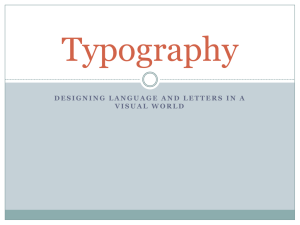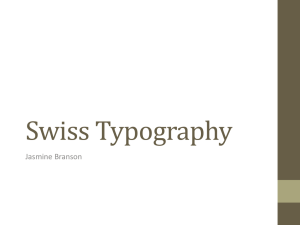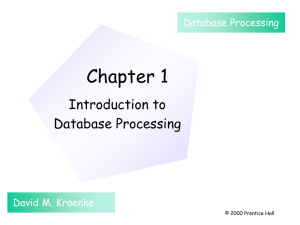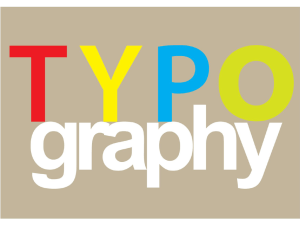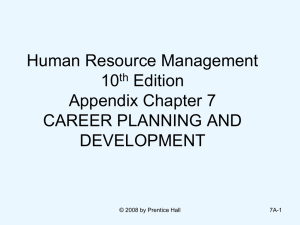Typography
advertisement
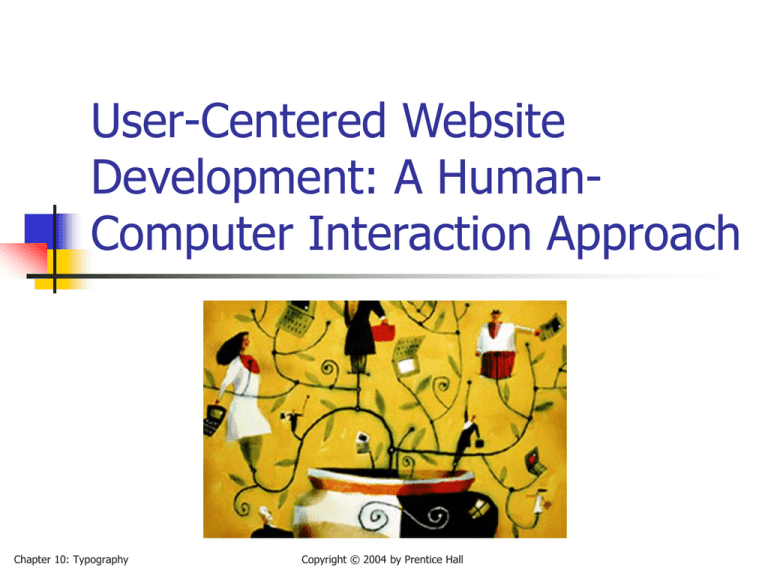
User-Centered Website Development: A HumanComputer Interaction Approach Chapter 10: Typography Copyright © 2004 by Prentice Hall Daniel D. McCracken City College of New York Rosalee J. Wolfe DePaul University With a foreword by: Jared M. Spool, Founding Principal, User Interface Engineering PowerPoint slides by Dan McCracken, with thanks to Rosalee Wolfe, S. Jane Fritz of St. Joseph’s College, and Rhonda Schauer Support from National Science Foundation Grant DUE 0088184, “User-Centered Web Site Design,” is gratefully acknowledged. Chapter 10: Typography Copyright © 2004 by Prentice Hall 10. Typography In this chapter you will learn about: The basic terminology and concepts of working with type A dozen typefaces and their characteristics What screen-friendly fonts are, and three examples How typography on the Web differs from typography in print How—using guidelines provided—to design typography for the Web that is readable, effective, and attractive Chapter 10: Typography Copyright © 2004 by Prentice Hall 10.2 Concepts and Terminology Chapter 10: Typography Copyright © 2004 by Prentice Hall A sans serif font, Arial Chapter 10: Typography Copyright © 2004 by Prentice Hall What does the size of a font mean? Chapter 10: Typography Copyright © 2004 by Prentice Hall These letters are all 72 points; the lines are one inch (= 72 points) apart How big type is depends on the font size and on the design of the font family. Don’t forget the “little bit”! The fonts are Garamond, Goudy, Bookman Old Style, AlleyCat ICG, Caslon Open Face, Arial Black, Park Avenue, and Ultra Condensed Sans Two Chapter 10: Typography Copyright © 2004 by Prentice Hall Some text with reduced line spacing, to show what happens without the “little bit” Chapter 10: Typography Copyright © 2004 by Prentice Hall Times New Roman, 10 point, with 1pt leading and with 3pt leading Chapter 10: Typography Copyright © 2004 by Prentice Hall 10.3 A (Bakers) Dozen Font Families 2 6 2 1 1 1 Chapter 10: Typography serif sans serif monospaced script Wingdings Symbol (Greek) Copyright © 2004 by Prentice Hall Times New Roman and its screen-friendly cousin Georgia—in same font size Chapter 10: Typography Copyright © 2004 by Prentice Hall Times Roman letters have oblique stress; Georgia has vertical stress Chapter 10: Typography Copyright © 2004 by Prentice Hall The pixel view: how Georgia gets vertical stress (and the letters are bigger) Chapter 10: Typography Copyright © 2004 by Prentice Hall Times New Roman and Georgia Chapter 10: Typography Copyright © 2004 by Prentice Hall Six sans serif fonts Chapter 10: Typography Copyright © 2004 by Prentice Hall Comparison of some sans serif fonts Arial bold and Arial Black Arial and Impact Arial and Comic Sans Arial and Trebuchet Chapter 10: Typography Copyright © 2004 by Prentice Hall Arial and its screen-friendly cousin Verdana—in same font size Chapter 10: Typography Copyright © 2004 by Prentice Hall Courier New and Times New Roman Courier New is a monospaced font: the comma gets as much horizontal space as the W. For program listings, this is exactly what we want. Seldom desirable otherwise. Chapter 10: Typography Copyright © 2004 by Prentice Hall A bit of C++ code in Courier Chapter 10: Typography Copyright © 2004 by Prentice Hall In Times New Roman the same thing seems strange—to a programmer Chapter 10: Typography Copyright © 2004 by Prentice Hall Andale Mono is a screen-friendly version of Courier Chapter 10: Typography Copyright © 2004 by Prentice Hall Nuptial Script Chapter 10: Typography Copyright © 2004 by Prentice Hall Webdings Chapter 10: Typography Copyright © 2004 by Prentice Hall The Greek alphabet in the Symbol font Chapter 10: Typography Copyright © 2004 by Prentice Hall 10.4 A Web Page is Not a Printed Page Some things a Web designer can’t be sure of: The resolution of the user’s monitor The size of the user’s browser window The text size: users can change it The settings and quality of the user’s monitor, in terms of brightness, contrast, and color balance The fonts available to a user Very different from print design! Chapter 10: Typography Copyright © 2004 by Prentice Hall 10.5 Text in graphics What if you want to use a font your users probably don’t have? Answer: make a graphic of it With a drop shadow Chapter 10: Typography Copyright © 2004 by Prentice Hall 10.6 Guidelines: Body Type on the Web Use Georgia or Verdana Use 10 point or 12 point type Avoid bold or italic in body type, except for a few words for emphasis Use upper case only for the first word of sentences, proper names, etc. Use left alignment Use dark text on a light background Never use underlining for emphasis Chapter 10: Typography Copyright © 2004 by Prentice Hall 10.7 Guidelines: Display type on the Web Big is beautiful Use any typeface that is legible—if your users have it; insert as a graphic if they don’t Use the HTML line-height attribute for control of line spacing Use HTML letter spacing and word spacing to get effects you want Don’t use any form of animation of text—ever Chapter 10: Typography Copyright © 2004 by Prentice Hall Summary In this chapter you learned: The basic terminology and concepts of typography A dozen typefaces and their characteristics What a screen-friendly font is, and how it works How typography on the Web differs from typography in print Guidelines for text and display type on the Web Chapter 10: Typography Copyright © 2004 by Prentice Hall
